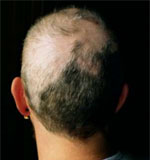I have been losing hair since I was about 17 (I am now 23), and I’m confused as my hair loss seems to have characteristics of both DUPA and typical MPB.
For example, I have a receding hairline and a small bald spot at the vertex – typical of MPB. However, I also have general thinning on the crown, forelock and down the sides and back of my head. Is it possible to have a receding hairline with DUPA? I was under the impression men with this kind of hair loss retained their hairlines.

 If you have the gene for male pattern baldness (MPB), the expression of the gene will dictate when the hair loss starts and which balding pattern that you will evolve into. In most people, the frontal loss starts at the leading edge of the frontal hairline, but a few people will keep their frontal hairline while they lose the hair behind it. When it comes to those with diffuse unpatterned alopecia (DUPA), the loss of the hairline as you describe is possible.
If you have the gene for male pattern baldness (MPB), the expression of the gene will dictate when the hair loss starts and which balding pattern that you will evolve into. In most people, the frontal loss starts at the leading edge of the frontal hairline, but a few people will keep their frontal hairline while they lose the hair behind it. When it comes to those with diffuse unpatterned alopecia (DUPA), the loss of the hairline as you describe is possible.
Here’s an excerpt from a paper published in 1997 referring to DUPA that may clarify: Diffuse Unpatterned Alopecia patients have a similar progression of balding as the DPA [diffuse patterned alopecia] patient except that the progression is often more rapid and will more likely eventuate in a “horseshoe pattern” resembling the Norwood class VII, except that in contrast to the Norwood VII, the DUPA “horseshoe” can look almost “transparent” due to the low density.
The hair on the sides and in the back of the head (a 3 inch high part of the scalp that starts at the body prominence of the skull aka the “horseshoe pattern” mentioned above) is looked at as permanent hair in most men. In the diagnosis of DUPA, this permanent zone has miniaturized hair in excess of 20%. The higher the miniaturized hair count in the permanent zone, the more difficult it will be to get enough good healthy donor hair for a hair transplant.
Women have what looks like DUPA in that same area and also often throughout the head. This makes most affected balding women poor candidates for hair transplantation.



 Matt Kelley was 38 when he first noticed a round, hairless spot in his beard. Within six weeks, every inch of his body that once had hair — including his eyebrows, eyelashes, arms and head — was completely bald.
Matt Kelley was 38 when he first noticed a round, hairless spot in his beard. Within six weeks, every inch of his body that once had hair — including his eyebrows, eyelashes, arms and head — was completely bald. 
 If you have the gene for male pattern baldness (MPB), the expression of the gene will dictate when the hair loss starts and which balding pattern that you will evolve into. In most people, the frontal loss starts at the leading edge of the frontal hairline, but a few people will keep their frontal hairline while they lose the hair behind it. When it comes to those with
If you have the gene for male pattern baldness (MPB), the expression of the gene will dictate when the hair loss starts and which balding pattern that you will evolve into. In most people, the frontal loss starts at the leading edge of the frontal hairline, but a few people will keep their frontal hairline while they lose the hair behind it. When it comes to those with